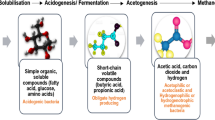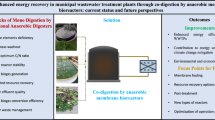Abstract
In India, many biogas plants process cattle dung (CD). At the same time, an excessive amount of litter of leaves is swept and burnt. The paper investigates small-scale integration of leaf litter of neem (LLN) to the operational CD-based biogas plant under mesophilic conditions. The introduction of LLN at the volatile solid ratio of 1:4 (LLN:CD) respectively increased daily biogas production, specific methane yield, and the resultant electrical energy by 13.11, 15.26, and 15.02% and reduced the proportion of CO2 by 5.85%. However, because of the energy required to pulverize the LLN in CD-LLN–based, the net percentage increase of the electrical energy dropped to 13.59%. CD-LLN–based reactor also produced 56.34% higher electrical energy per organic substrate added and performed well by 15.0% in terms of CO2 emission compared to CD-based. Digester performance was seriously unaffected during the transition stage. The study highlights another way of managing LLN and shifting anaerobic reactors from one feedstock to another.



Similar content being viewed by others
References
Mohammad S, Ardebili S, Khademalrasoul A (2020) An assessment of feasibility and potential of gaseous biofuel production from agricultural / animal wastes : a case study. Biomass Convers Biorefinery
Chieng S, Kuan SH (2020) Harnessing bioenergy and high value–added products from rice residues: a review. Biomass Convers Biorefinery. https://doi.org/10.1007/s13399-020-00891-y
Nayeem-Shah M, Gajalakshmi S, Abbasi SA (2014) Direct, rapid and sustainable vermicomposting of the leaf litter of neem (Azadirachta indica). Appl Biochem Biotechnol 175:792–801. https://doi.org/10.1007/s12010-014-1339-7
Koul O (2006) Neem: a global perspective. Neem Today New Millenn:1–19. https://doi.org/10.1007/1-4020-2596-3_1
Rajkumar P (2020) Somasundaram M. Non-isothermal conversion of wheat husk and low-density polyethylene for energy dense fuel production, Biomass Convers Biorefinery
Sivakumar S, Kasthuri H, Prabha D, Senthilkumar P, Subbhuraam CV, Song YC (2009) Efficiency of composting parthenium plant and neem leaves in the presence and absence of an oligochaete, Eisenia fetida. Iran J Environ Heal Sci Eng 6:201–208
Wong JWC, Mak KF, Chan NW, Lam A, Fang M, Zhou LX, Wu QT, Liao XD (2001) Co-composting of soybean residues and leaves in Hong Kong. Bioresour Technol 76:99–106. https://doi.org/10.1016/S0960-8524(00)00103-6
Cheng J, Ding L, Lin R, Yue L, Liu J, Zhou J, Cen K (2016) Fermentative biohydrogen and biomethane co-production from mixture of food waste and sewage sludge : effects of physiochemical properties and mix ratios on fermentation performance. Appl Energy 184:1–8. https://doi.org/10.1016/j.apenergy.2016.10.003
Varsha SSV, Soomro AF, Baig ZT, Vuppaladadiyam AK, Murugavelh S, Antunes E (2020) Methane production from anaerobic mono- and co-digestion of kitchen waste and sewage sludge: synergy study on cumulative methane production and biodegradability. Biomass Convers Biorefinery. https://doi.org/10.1007/s13399-020-00884-x
Akbulut A (2012) Techno-economic analysis of electricity and heat generation from farm-scale biogas plant: Çiçekdaĝi{dotless} case study. Energy 44:381–390. https://doi.org/10.1016/j.energy.2012.06.017
Veluchamy C, Kalamdhad AS (2020) Screening of different thermal heating processes for increased methane production from lignocellulose waste material. Biomass Convers Biorefinery. https://doi.org/10.1007/s13399-020-00886-9
Westerholm M, Moestedt J, Schnürer A (2016) Biogas production through syntrophic acetate oxidation and deliberate operating strategies for improved digester performance. Appl Energy 179:124–135. https://doi.org/10.1016/j.apenergy.2016.06.061
Chandra R, Vijay VK, Subbarao PMV, Khura TK (2011) Performance evaluation of a constant speed IC engine on CNG, methane enriched biogas and biogas. Appl Energy 88:3969–3977. https://doi.org/10.1016/j.apenergy.2011.04.032
Chandra R, Takeuchi H, Hasegawa T (2012) Hydrothermal pretreatment of rice straw biomass: a potential and promising method for enhanced methane production. Appl Energy 94:129–140. https://doi.org/10.1016/j.apenergy.2012.01.027
Pal K, Patra AK, Sahoo A, Kumawat PK (2015) Evaluation of several tropical tree leaves for methane production potential, degradability and rumen fermentation in vitro. Livest Sci 180:98–105. https://doi.org/10.1016/j.livsci.2015.07.011
Akyol Ç, Ince O, Bozan M, Ozbayram EG, Ince B (2019) Fungal bioaugmentation of anaerobic digesters fed with lignocellulosic biomass: what to expect from anaerobic fungus Orpinomyces sp. Bioresour Technol. https://doi.org/10.1016/j.biortech.2019.01.024
Ferraro A, Massini G, Mazzurco Miritana V, Signorini A, Race M, Fabbricino M (2019) A simplified model to simulate bioaugmented anaerobic digestion of lignocellulosic biomass: biogas production efficiency related to microbiological data. Sci Total Environ 691:885–895. https://doi.org/10.1016/j.scitotenv.2019.07.051
Nzila A (2017) Mini review: update on bioaugmentation in anaerobic processes for biogas production. Anaerobe 46:3–12. https://doi.org/10.1016/j.anaerobe.2016.11.007
Ma S, Wang H, Li J, Fu Y, Zhu W (2019) Methane production performances of different compositions in lignocellulosic biomass through anaerobic digestion. Energy 189:116190. https://doi.org/10.1016/j.energy.2019.116190
Negro V, Alvarado-Morales M, Tsapekos P, Fino D, Ruggeri B, Angelidaki I (2020) Co-digestion of orange peels and marine seaweed with cattle manure to suppress inhibition from toxicants. Biomass Convers Biorefinery. https://doi.org/10.1007/s13399-020-00912-w
Li Y, Xu H, Hua D, Zhao B, Mu H, Jin F, Meng G, Fang X (2020) Two-phase anaerobic digestion of lignocellulosic hydrolysate: focusing on the acidification with different inoculum to substrate ratios and inoculum sources. Sci Total Environ 699:134226. https://doi.org/10.1016/j.scitotenv.2019.134226
Kafle GK, Kim SH (2013) Anaerobic treatment of apple waste with swine manure for biogas production: batch and continuous operation. Appl Energy 103:61–72. https://doi.org/10.1016/j.apenergy.2012.10.018
Pöschl M, Ward S, Owende P (2010) Evaluation of energy efficiency of various biogas production and utilization pathways. Appl Energy 87:3305–3321. https://doi.org/10.1016/j.apenergy.2010.05.011
Sahoo A, Kumar S, Mohanty K (2020) A comprehensive characterization of non-edible lignocellulosic biomass to elucidate their biofuel production potential. Biomass Convers Biorefinery. https://doi.org/10.1007/s13399-020-00924-6
Chandra R, Vijay VK, Subbarao PMV, Khura TK (2012) Production of methane from anaerobic digestion of jatropha and pongamia oil cakes. Appl Energy 93:148–159. https://doi.org/10.1016/j.apenergy.2010.10.049
Ajieh MU, Ogbomida TE, Onochie UP, Akingba O, Kubeyinje BF, Orerome OR, Ogbonmwan SM (2020) Design and construction of fixed dome digester for biogas production using cow dung and water hyacinth. African J Environ Sci Technol 14:15–25. https://doi.org/10.5897/ajest2019.2739
Castano JM, Martin JF, Ciotola R (2014) Performance of a small-scale, variable temperature fixed dome digester in a temperate climate. Energies 7:5701–5716. https://doi.org/10.3390/en7095701
Sharma VK, Testa C, Lastella G, Cornacchia G, Comparato MP (2000) Inclined-plug-flow type reactor for anaerobic digestion of semi-solid waste. Appl Energy 65:173–185. https://doi.org/10.1016/S0306-2619(99)00084-7
Muhammad M., Okoye F. Design, construction and performance analysis of biogas digester for Sharda University India. Int J Mech Eng 2016;3:1–10. https://doi.org/10.14445/23488360/ijme-v3i8p101
Pragya G, Sreekrishnan TR, Ahammad SZ (2015) Acclimatization of anaerobic sludge to treat Cr (VI) and 4-CP present in industrial effluents and their effect on microbial communities. J Hazard Toxic Radioact Waste:80–88. https://doi.org/10.1061/(ASCE)HZ
Petre V, Petre M, Rusea I, Stănică F. Biotechnological recycling of fruit tree wastes by solid-state cultivation of mushrooms. Mushroom Biotechnol. Dev. Appl., 2016, p. 19–29. https://doi.org/10.1016/B978-0-12-802794-3.00002-3
Chandra R, Takeuchi H, Hasegawa T (2012) Methane production from lignocellulosic agricultural crop wastes : a review in context to second generation of biofuel production. Renew Sust Energ Rev 16:1462–1476. https://doi.org/10.1016/j.rser.2011.11.035
Zhang C, Su H, Baeyens J, Tan T (2014) Reviewing the anaerobic digestion of food waste for biogas production. Renew Sust Energ Rev 38:383–392. https://doi.org/10.1016/j.rser.2014.05.038
Callaghan FJ, Wase DAJ, Thayanithy K, Forster CF (2002) Continuous co-digestion of cattle slurry with fruit and vegetable wastes and chicken manure. Biomass Bioenergy 22:71–77. https://doi.org/10.1016/S0961-9534(01)00057-5
Ahmed B, Tyagi VK, Priyanka, Khan AA, Kazmi AA. Optimization of process parameters for enhanced biogas yield from anaerobic co-digestion of OFMSW and bio-solids. Biomass Convers Biorefinery 2020. https://doi.org/10.1007/s13399-020-00919-3
Zamanzadeh M, Hagen LH, Svensson K, Linjordet R, Horn SJ (2016) Anaerobic digestion of food waste - effect of recirculation and temperature on performance and microbiology. Water Res 96:246–254. https://doi.org/10.1016/j.watres.2016.03.058
Sreekrishnan TR, Kohli S, Rana V. Enhancement of biogas production from solid substrates using different techniques –– a review 2004;95:1–10. https://doi.org/10.1016/j.biortech.2004.02.010
Chandra R, Takeuchi H, Hasegawa T, Kumar R (2012) Improving biodegradability and biogas production of wheat straw substrates using sodium hydroxide and hydrothermal pretreatments. Energy 43:273–282. https://doi.org/10.1016/j.energy.2012.04.029
Aǧdaǧ ON, Sponza DT (2005) Co-digestion of industrial sludge with municipal solid wastes in anaerobic simulated landfilling reactors. Process Biochem. https://doi.org/10.1016/j.procbio.2004.06.057
Gou C, Yang Z, Huang J, Wang H, Xu H, Wang L (2014) Effects of temperature and organic loading rate on the performance and microbial community of anaerobic co-digestion of waste activated sludge and food waste. Chemosphere 105:146–151. https://doi.org/10.1016/j.chemosphere.2014.01.018
Lahboubi N, Kerrou O, Karouach F, Bakraoui M, Schüch A, Schmedemann K, Stinner W, el Bari H, Essamri A (2020) Methane production from mesophilic fed-batch anaerobic digestion of empty fruit bunch of palm tree. Biomass Convers Biorefinery. https://doi.org/10.1007/s13399-020-00864-1
Yangin-Gomec C, Ozturk I (2013) Effect of maize silage addition on biomethane recovery from mesophilic co-digestion of chicken and cattle manure to suppress ammonia inhibition. Energy Convers Manag 71:92–100. https://doi.org/10.1016/j.enconman.2013.03.020
Author information
Authors and Affiliations
Corresponding author
Additional information
Publisher’s Note
Springer Nature remains neutral with regard to jurisdictional claims in published maps and institutional affiliations.
Rights and permissions
About this article
Cite this article
Muhammad, M.B., Chandra, R. & Payal, H. A method for shifting of cattle dung based biogas digester for enhanced anaerobic co-digestion of cattle dung with leaf litter of neem. Biomass Conv. Bioref. 13, 833–840 (2023). https://doi.org/10.1007/s13399-020-01166-2
Received:
Revised:
Accepted:
Published:
Issue Date:
DOI: https://doi.org/10.1007/s13399-020-01166-2




